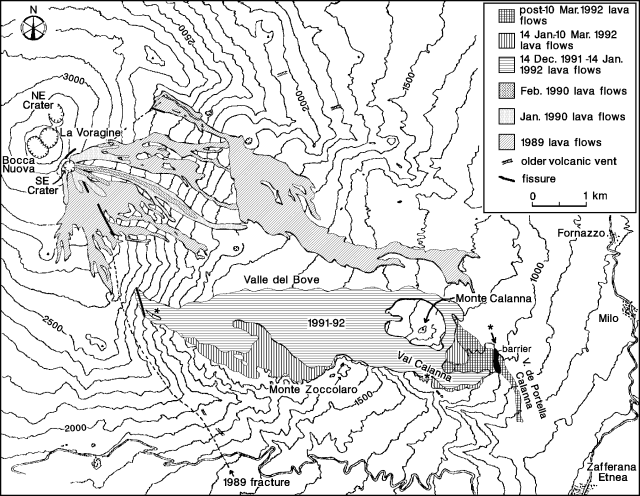Report on Etna (Italy) — April 1992
Bulletin of the Global Volcanism Network, vol. 17, no. 4 (April 1992)
Managing Editor: Lindsay McClelland.
Etna (Italy) SE-flank fissure eruption continues; lava diversion attempted
Please cite this report as:
Global Volcanism Program, 1992. Report on Etna (Italy) (McClelland, L., ed.). Bulletin of the Global Volcanism Network, 17:4. Smithsonian Institution. https://doi.org/10.5479/si.GVP.BGVN199204-211060
Etna
Italy
37.748°N, 14.999°E; summit elev. 3357 m
All times are local (unless otherwise noted)
Lava has emerged from a SE-flank fissure in the W wall of the Valle del Bove since 15 December, covering an estimated 7.3 km2 with ~ 100 x 106 m3 of lava. A well-developed tube system carried lava downslope, threatening the town of Zafferana Etnea and prompting attempts at lava diversion (figure 47). The lava production rate, as observed through numerous skylights along the main lava tube, has remained relatively constant, but distal flow fronts advanced at varying rates. The apparent intensity of gas emission from the eruptive fissure changed with weather conditions. During the last 10 days of April, fumarolic activity was observed in the W wall of the Valle del Bove, extending upslope from the eruptive fissure along its NNW trend. This zone was active on 14 December during the initial phase of the eruption.
Lava overwhelmed a series of barriers in early April, and advanced 1 km down a gorge (within the Valle di Portella Calanna) toward Zafferana during the second week in April. This flow stopped on 15 April at 750 m elevation, roughly 1.5 km from the inhabited center of Zafferana. Numerous ephemeral vents began to form below 1,000 m elevation on 19 April (on the E edge of Val Calanna, in which a barrier had been built in early January). Flows from these vents covered lava from previous days along the gorge below Portella Calanna. The longest stopped during the evening of 25 April at 755 m altitude, ~ 7.5 km from the eruptive fissure and 1.5 km from the center of Zafferana. Lava flows originated from a large ephemeral vent at the head of Val Calanna in the beginning of May, passing Portella Calanna atop previous flows on 6 May and reaching 850 m asl that evening.
Ephemeral vents also developed upslope, within the wide lava field that had formed in the S part of the Valle del Bove during previous months. The first formed around 1,900 m altitude (at Monte del Rifugio Menza) on 22 April, and a second occurred near the center of the lava field, at around 1,550 m elevation (near Poggio Canfareddi) on 25 April. Flows from these vents were not very substantial and were no longer active a few days later. On 5 May, only a modest active vent at the N edge of the lava field (around 1,600 m elevation) was observed.
Experiments with the use of explosives, cement blocks, and, more recently, lava blocks continued at skylights in the main lava tube (in the upper Valle del Bove, at around 2,100 m altitude, on 17, 21, and 29 April, and 4 May) and at ephemeral vents (near Portella Calanna on 15 April and in Val Calanna on 6 May). These were designed to cause lava overflows and thus reduce the amount of lava carried in tubes toward inhabited areas. As of early May, it was difficult to evaluate whether these experiments had favorably affected the course of the eruption. On 4 May an overflow began from a skylight in the main lava tube at around 2,100 m altitude, where blocks of cement had been dropped and explosives detonated on previous days. The modest overflow moved over the lava field that had formed in the preceding months. However, during this time, numerous ephemeral vents, varying daily in number and location, remained active above Zafferana at the head of Val Calanna (in the Salto della Giumenta).
Slow, weak degassing continued through early May from the summit craters. Weak ash ejections, caused by internal collapse, were observed only from Northeast Crater, on 22 April. Early April-early May seismic activity was much reduced from previous months.
Geological Summary. Mount Etna, towering above Catania on the island of Sicily, has one of the world's longest documented records of volcanism, dating back to 1500 BCE. Historical lava flows of basaltic composition cover much of the surface of this massive volcano, whose edifice is the highest and most voluminous in Italy. The Mongibello stratovolcano, truncated by several small calderas, was constructed during the late Pleistocene and Holocene over an older shield volcano. The most prominent morphological feature of Etna is the Valle del Bove, a 5 x 10 km caldera open to the east. Two styles of eruptive activity typically occur, sometimes simultaneously. Persistent explosive eruptions, sometimes with minor lava emissions, take place from one or more summit craters. Flank vents, typically with higher effusion rates, are less frequently active and originate from fissures that open progressively downward from near the summit (usually accompanied by Strombolian eruptions at the upper end). Cinder cones are commonly constructed over the vents of lower-flank lava flows. Lava flows extend to the foot of the volcano on all sides and have reached the sea over a broad area on the SE flank.
Information Contacts: R. Romano and T. Caltabiano, IIV; P. Carveni and M. Grasso, Univ di Catania.


